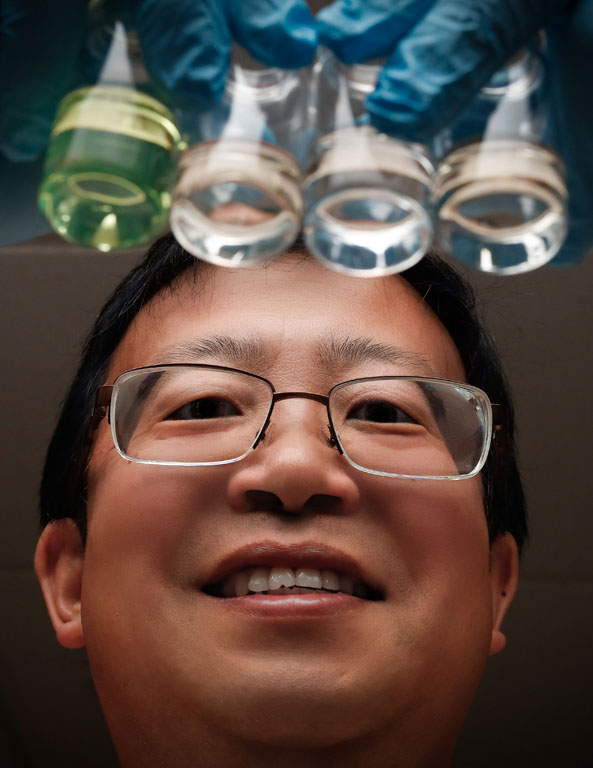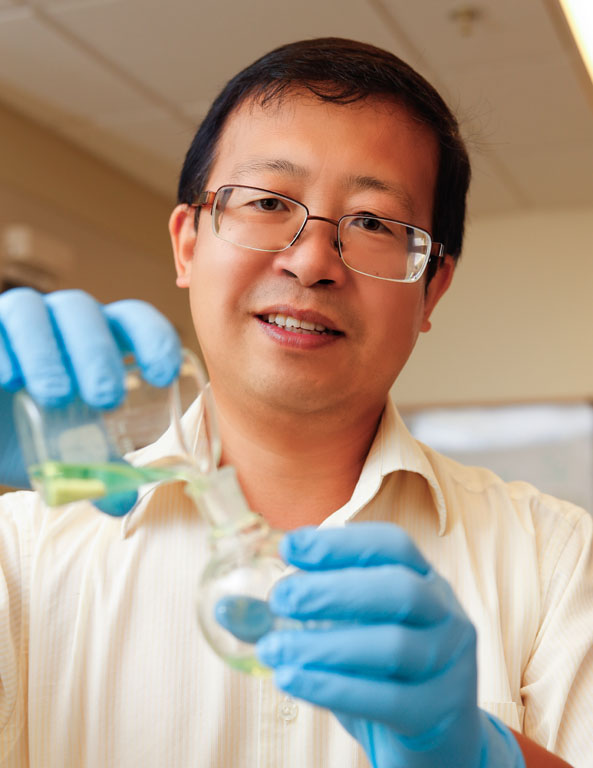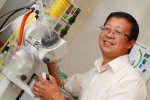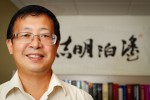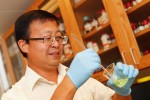Hydrogen sulfide is an interesting compound. H2S.
A colorless gas, it’s that stinky rotten egg smell.
It’s toxic and volatile – can make humans and animals sick or it can explode.
But chemists such as University of Nebraska at Kearney’s Haishi Cao know the human body produces small amounts of H2S as a signaling molecule.
As a top university researcher in bio-organic chemistry, Cao may one day find the right amount of hydrogen sulfide that in the brain could be a cure for neurodegenerative diseases such as Parkinson’s or Alzheimer’s.
That’s what keeps Cao and his students working in their Bruner Hall labs day in and day out – the quest for discovery of the exact compound or molecular “sensors” that can measure the level of H2S that will help – not kill – cells, leading to treatments or even cures for cell- and nerve-damaging diseases in the brain.
Fluorescence – that neon-like glow – is the signal that Cao and his undergraduate lab assistants observe, detect and measure to help discover that right mix and measure of hydrogen sulfide and other compounds.
“Our job is to find out how much of this molecule is helpful,” Cao said. “A large amount is very toxic. A small amount is very helpful.
“That molecule (hydrogen sulfide) is very useful. It is toxic, but in our brain… in our body – the loss of hydrogen sulfide is the key to our brain housing.”
Scientists have speculated that hydrogen sulfide is useful in mitigating cell damage that’s responsible for specific diseases. Time magazine in July 2014 featured a discovery by researchers at England’s University of Exeter who reported in the journal “Medicinal Chemistry Communications,” that small amounts of H2S could prevent mitochondrial damage. (Mitochondria supply cellular energy and also are involved in signaling, differentiation and cell death, while maintaining cell growth.) Discovering how much of a tiny amount of hydrogen sulfide is beneficial to cells’ mitochondria could lead to prevention of arthritis, heart disease, strokes, as well as neurodegenerative diseases.
The same team in 2013 published research that hydrogen sulfide activates a gene linked to longevity, similar to resveratrol, the antioxidant in red wine.
So what was used as a chemical weapon during World War I is now a hot area of research for labs around the world – like Cao’s. The race is on to discover the precise level of H2S to eventually cure these diseases. Cao dreams of winning that race.
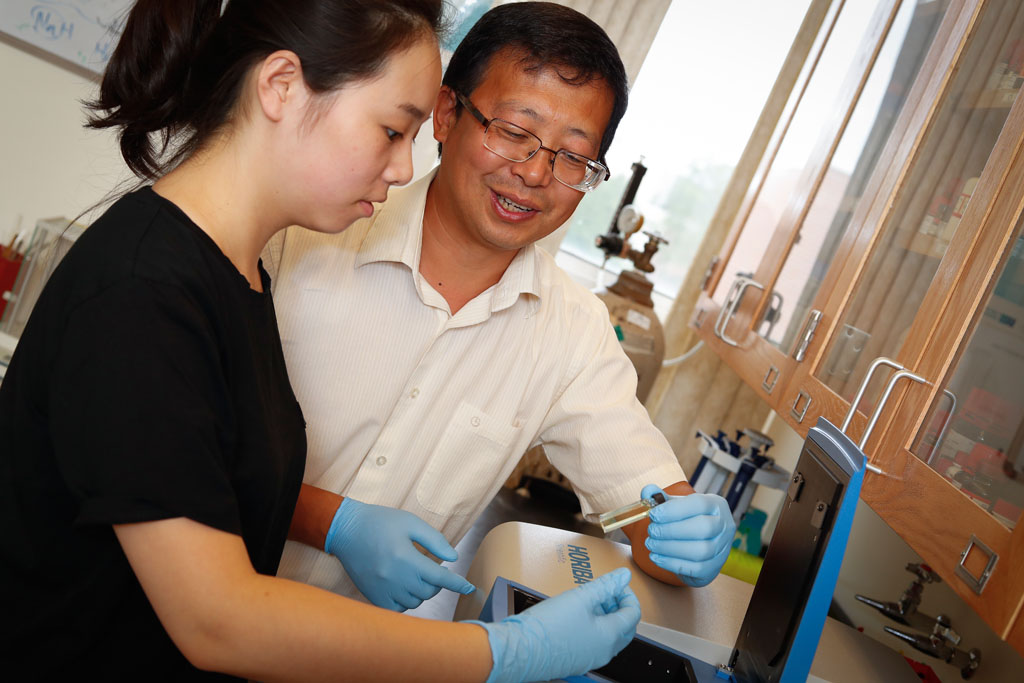 “I’m really interested in the medical application. Discovering the final target,” he said. “Lots of diseases have small molecules and low concentrations that have significant regulation for the species. People have a really hard time detecting these small molecules. They’re not visible so we have to use (special) techniques to figure out how many molecules are there.
“I’m really interested in the medical application. Discovering the final target,” he said. “Lots of diseases have small molecules and low concentrations that have significant regulation for the species. People have a really hard time detecting these small molecules. They’re not visible so we have to use (special) techniques to figure out how many molecules are there.
“I’m interested in nervous disease like Parkinson’s. There are many factors that can affect this disease-cause. It’s a really complicated process. I’m interested in this very small part, which is hydrogen sulfide. That is the molecules that can keep the reduction foundation in the cell, and can keep the cell normal. I want to know what’s their function.”
Armed with his lab instruments and aided by as many as six undergraduate students at a time, Cao is analyzing, measuring and tracking precise numbers and types of molecules and their reactions.
“Most fluorescent molecules are organic compounds with a highly conjugated structure,” Cao said. “The fluorescent properties can be changed under different environments or through interacting with other molecules. I work on this with my students every day.”
Cao points to a vent-hooded table where the toxic hydrogen sulfide is analyzed by UNK students.
Cao turns serious: “I tell the students, some of this is very toxic so we look at these molecules under the hood… these could explode or they could get sick, these are toxic.” He holds up a test tube and puts it in a small black box under ultraviolet light. It is glowing.
“This is the molecule. We made it, it is fluorescent. My compound is very visible. You can see the color there.” Some are glowing blue, or green or yellow. The concentrations of H2S are so small, even as small as 1 part per billion. The exact measurement of the number of micromoles or nanomoles is important, requiring precise instruments.
“How this hydrogen sulfide in the cell interacts with the molecules we make here… results in fluorescence. Based on the change we know how much hydrogen sulfide. It’s the change of both intensity and color.”
The chemistry labs include other equipment: a nuclear magnetic resonance instrument (like a medical MRI that detects anomalies in the body). The NMRI characterizes the structure of compounds, so when they are developed, Cao and students know they are pure.
“We have to use this instrument to identify whether we get the right or wrong compound. We propose to make some molecules but we verify that we get the right one. If the compound is right we can go to the next step, we can (measure) fluorescence. This is the second step for our research. The first was under the hood to make the molecules. Then we purify that, then we come here to verify the structure, to make sure we get the right compound, and if it’s correct then we go to the fluorimeter.”
A fluorimeter measures the fluorescent excitation and emission: the wavelength and intensity.
“Fluorescence is an emission when electrons go back from an excited state to a grounded state,” Cao said. “Moving around in a nucleus the electrons are pretty stable, pretty relaxed, pretty comfortable. However, if you put anything to the electrons, the electrons get pretty crazy. Ah, really powerful and really excited, so what do they do, they jump higher. Like the kids. When you give them some candy they get very happy. So electrons, they give off energy. This energy is light. So when you make the electrons very excited, they jump to somewhere. We call this the excited state. When these electrons go back from the excited state to normal, they give off fluorescence.
“We use one instrument to measure the fluorescence. We use this one – a spectrometer – to measure absorption.
Sometimes we can say the absorption will determine the fluorescence. Sometimes we’re interested in one or the other. Whenever we’re investigating some bio-event like how the molecules interact with hydrogen sulfide, we want to know how much absorption is there, and how much fluorescence.”
While most research universities have this array of instruments, it’s rare to find them in a university such as UNK, a teaching institution, where undergraduates are routinely working on them.
“I show them first (laughing). Eventually they learn how to use it themselves. There’s no problem,” he says.
The last step is to hand off the sample to biology researcher Kim Carlson for her lab to test in mice and human (monocytic) cell lines.
Passion For Science, Color
Haishi Cao (pronounced “sow”) was born in Changchun China, the son of two professors (both literature). Destined to teach.
“Changchun is northeast. It’s kind of a big city. Our weather is very close to Nebraska. The main agricultural product is corn. I came to the U.S. in 1999. Then I went to New Mexico to get my Ph.D., then to Washington state to do postdoc there for three years, then moved to Kearney in 2007. I really like chemistry, and I know there are some really good universities in the United States and I thought it would be a good advantage to go to the U.S. to get my degree.
“The United States was a very interesting country to me. I learned a lot in China, but most of what I learned about it I saw on TV and read in books. I just was very curious about what this country is.”
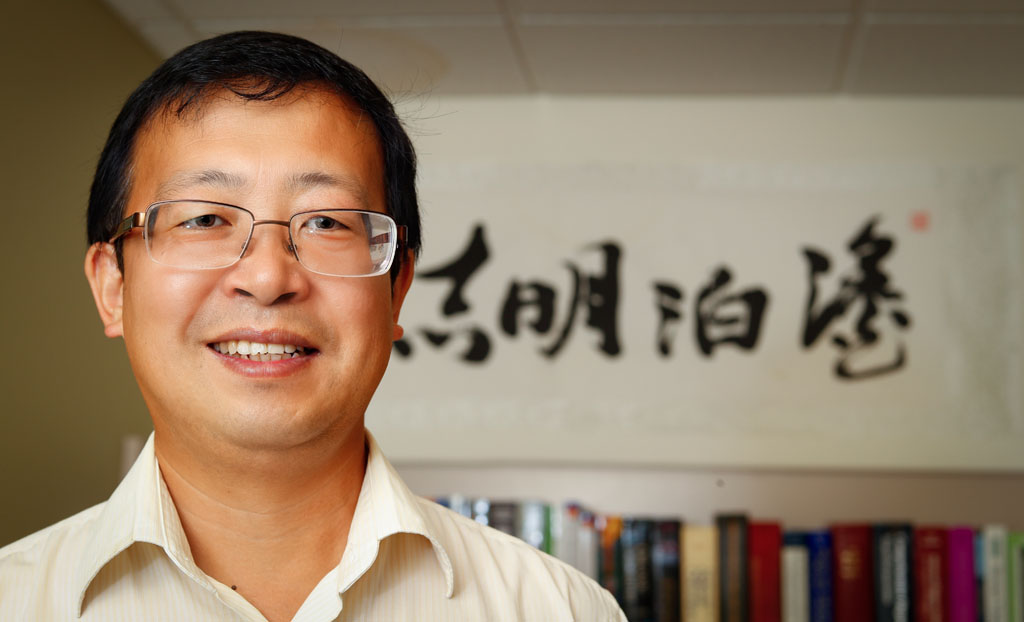 Cao said chemistry always came naturally to him, but he knows it doesn’t come easily to everyone. He has always been passionate about experimentation and science.
Cao said chemistry always came naturally to him, but he knows it doesn’t come easily to everyone. He has always been passionate about experimentation and science.
“When I was in middle school I took lots of physics, math and chemistry and just found chemistry was super easy for me,” he said. “I discovered chemistry was my work. I love demo (experiments). Even right now. There are some amazing things you can see from demo. How do molecules affect each other. That’s what drew me to the chemistry major. I love it.”
Cao is an easy conversationalist but wants to talk more about his students and about hydrogen sulfide. About other things that brought him to chemistry.
“I cannot see color,” he says. “I’m not completely color blind, but I cannot distinguish color easily. That makes me really like color, actually. When I get to see something in color, that’s amazing for me. Things that I see, I like the fluorescence, that makes me see the color. Say there’s a flower with red flower and green leaves. Some people ask me if I can see significant contrast and I say ‘no, I say they are the same.’ I can see the difference between yellow and green.
“For my research I don’t need to see the colors. We rely on the instrument. And another advantage for the fluorescence is it is super sensitive. You can have a really tiny amount and see it. You don’t need too much.”
Natural Teacher
Cao is most pleased talking about teaching and about watching his students succeed, celebrating in their success with them. He teaches a few different chemistry courses, but primarily organic chemistry, usually a class of 45 with two to three labs.
“I think I got some genetic thing from my parents. I love students, I really do.
“I really enjoy explaining what I learn. When I talk to students I say… in China things are different. In the U.S. they teach us something one way. I like to share my learning and the way I learned things in another country. I tell students: ‘you can think about things this one way. Or you can think of things this other way. You learn which way is better for you. I’m an opportunity to find another way for you.’”
“They laugh. ‘Oh that’s weird.’”
His greatest joy, he said, comes from watching and learning that his students have succeeded.
“There are two things that make me very happy: One, whenever a student gets an acceptance to grad school or medical school. Every March or April I’ll hear some students get accepted to medical school or grad school, and they are so excited about it.” He keeps track of his students on his website, and they’ll contact him to let him know where they are.
Still, organic chemistry is tough. Some students really struggle and aren’t successful. He takes joy in their success and works hard to help.
“I think that’s part of my job (to help students work through this). I understand organic chemistry and people think it is a horrible class. It’s time-consuming. It’s very different from other chemistry. You have to be careful of all of the details. If you miss one, you will mess up. You should be careful if you miss one step. You should use all of your knowledge, not just one (part).
“I don’t want students to feel frustrated. I don’t want students to feel like they will fail. I will help students get through this class. If they’re having some difficulty, I will help them get better. Most of the students end up feeling this is a hard class, but it’s not a disaster. Every year I see one or two students who are totally lost. I tell them sometimes ‘this is just not for you.’ We are human. We can’t be perfect or good at everything. I tell my students ‘if I take art or music class I am horrible. Art or singing is a disaster (for me). But if I am good at chemistry, I choose chemistry. If chemistry doesn’t work for you that’s not a bad thing. You can find something.’”
Cao is a frequent author for articles in Journal of Fluorescence, Organic & Biomedical Chemistry, New Journal of Chemistry and others. He always puts his students as authors on his papers. Funding for his students comes primarily from National Institutes of Health (INBRE) and from the Nebraska Research Initiative. Carlson says he is prolific in publishing and amazingly fast with his experimentation. “The students love him,” she said.
Says Cao: “This is a teaching institution. I love research, but I love teaching. I really enjoy working with students. It’s a beautiful thing. In this department and at UNK we have the opportunity to balance this so we can do research and teaching. I would say it is perfect. You have lots of freedom to do your research, you have time, you get instrument support. Students like to be involved in the research. We emphasize teaching and we represent high-quality teaching.
“I tell my students ‘Do your research seriously. Don’t just come here to be here. Do your research and get the result. We want to get the result for publication.’ (My students) are the major contributors. This is why I like to list them. I like to emphasize the students and to get them confidence. I want them to feel they can do something in the lab. A lot of times when my students come to the lab they are not very confident. They want to know: ‘Can I do that?’ I say: ‘Yes you can do that.’ I want to show them. But ‘yes you should work hard and yes you should be serious.’ If they’re worried they’re going to break something I say ‘yes and I break something, too.’
“So chemistry lab is about conquering their fear.”
‘Enjoy What You Have Right Now’
Above Cao’s desk is a beautiful Chinese calligraphy. His father, a professor of rhetoric at a university in China, wrote it for him. It says, loosely translated: “Enjoy what you have right now.”
That’s Cao’s personality and attitude in a nutshell.
“I really love this place, actually,” he says. “I’m proud of our department. We’re pretty unique. Good people. Our culture. I visited some other institutions in Nebraska, and our department is really good. Our facility, our people, our teaching. We’re outstanding.”
Cao and his wife, Yue, are parents to daughter Isabella, who is 11 going on 30, and Cao beams when he talks about her.
“Travel is one of my favorite things. I like driving. I like to go to Colorado. But I like to go anywhere. My daughter doesn’t like it so much. She feels like it is boring. When she was little she liked it, but now she is almost a teenager and she doesn’t like being with me (laughs). I like hiking. I like being close to Colorado and the mountains there.”
He lives for his research. Carlson says he’s far ahead of the curve on this research.
Perhaps a major “Time magazine discovery” is one fluorimeter test away.
-30-
